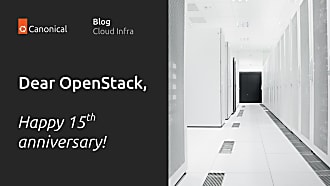Miona Aleksic
on 29 November 2022
VMware to open source: what do you need to consider?
You might have read our previous blog VMware alternatives: discover open source where we discussed why you should consider open source-based infrastructure if you’re looking for VMware alternatives. We also held a webinar on the topic, where we received quite a lot of relevant audience questions that we wanted to elaborate on further. Read on for some of the most important considerations when thinking about migrating from VMware to Ubuntu-based open-source infrastructure.
What’s the best option for my use case?
If you’re running a VMware-based infrastructure, chances are you are using a variety of VMware products. VMware offers a wide range of tools, outside of the most famous vSphere, and they cover a wide range of needs including storage, networking, orchestration and automation solutions.
Finding the right alternative to VMware hugely depends on your specific use case:
- How big is your deployment and how big do you expect it to be in the future?
- What kind of storage and networking options do you need?
- What kind of workloads do you want to run?
- What kind of endpoints need to be exposed and what kind of outside tools does it need to be integrated with?
All of these questions, and more, are important to consider when designing an appropriate solution.
Canonical has a wide range of infrastructure products that can be combined in different ways to deliver a full solution for your specific needs. It is difficult, and it would be misleading, for us to recommend one single option as a like-for-like alternative.
If you are after a full private cloud on a mid to large scale, our Openstack solution might be the right one for you. If you are looking for a virtualisation layer, you might be interested in LXD, or an LXD-based MicroCloud for a small-scale deployment. If you are interested in running cloud-native workloads our Kubernetes offering is the one to go with. Our Charmed Ceph solution might be suitable for your storage needs. There is no one-size, or rather a one-solution-fits-all approach.
If you want to explore what the best alternative would be for your specific use case, our team of experts can help you make that assessment. Whether it’s just straightforward lift & shift activities, or there are changes that need to be made prior to migration, our experts can help you find the right solution and plan your migration activities.
Some VMware products also require specific hardware, so you might be wondering what that would mean from a migration standpoint.
Can I reuse existing hardware?
When it comes to hardware, if you’re looking to adopt Ubuntu-based infrastructure instead, the rule of thumb is that you can use hardware that is certified on Ubuntu. This means that we test it on a regular basis and we know it will seamlessly run both Ubuntu and our cloud and virtualisation products to deliver a cloud environment.
Nevertheless, there are situations where your existing hardware might not fit the requirements for your future infrastructure. We typically have recommendations on what hardware should be used for which solution in order to achieve the best price-performance, taking the scalability of the solution into account as well. If you’d like to discuss this, please reach out to us via the contact form.
How to perform a seamless migration?
The migration process and tooling are also very dependent on the kind of workloads you are running, as well as what kind of platform you want to migrate to. Some of our products have their own migration tools or functionalities that can be used, such as the LXD migration tool or the OpenStack Nova live migration function. For other use cases, we often collaborate with partners that provide migration as a service, such as Cloudbase.
Migrating from one platform to another can be as simple as a direct lift & shift, or you can utilise the migration as an opportunity to modernise your workloads as well, and ensure you are not dragging your outdated legacy systems into the future along with the high costs of maintaining them. If you are curious about what the process looks like for both of these approaches read our recently published whitepaper.
What about open-source backup solutions?
Canonical doesn’t offer its own backup solution for cloud infrastructure. There are several native open-source backup solutions that are available for infrastructure products, as well as proprietary ones. As a company, we collaborate with leading ISVs to provide integrations for our infrastructure, and it’s really up to the customer if they want to stick to open source or leverage some well-performing proprietary solutions on top of their open-source infrastructure.
What about SLAs and the support matrix?
Canonical offers support via our Ubuntu Pro offering, and you can see more details and the full price list on our support page.
What’s next?
Over the coming months, we will be diving deeper into some of these topics as well as exploring specific migration scenarios. Keep an eye out for future articles and webinars.
If you are actively looking for a VMware alternative, reach out to us to discuss your specific use case and our experts can guide you through the migration requirements and embracing open source-based infrastructure.
Further Reading
Learn more about Canonical’s open source infrastructure solutions.



